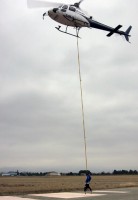ADEL ABDESSEMED
عادل عبدالصمد
אדל אבדסמד
Адель Абдессемед
Helicopter
source: artinfo
Adel’s Nightmares
Who really is Adel Abdessemed? He has been reclusive for the past several years, protecting himself behind a multitude of aesthetic and symbolic references. Indeed, his show is titled “Je Suis Innocent” (“I Am Innocent”), as if he were Pontius Pilate washing his hands of the violence of others. The subtext of this title could be, “The world, people, and art, are all brutal — not me,” suggesting that the violence of which he’s been accused of basing his work on (a show of animal snuff videos was even removed from the San Francisco Art Institute) came from somewhere else. Abdessemed is claiming to be just a passerby, a printing plate, a slightly distorting mirror.
In the artist’s work, the shock is first visual and unpredictable, like a well-placed headbutt or a left hook. At the Pompidou, snakes and frogs kill each other on camera (in “Usine” or “Factory,” from 2008); a piglet eagerly nurses at a woman’s breast (“Lise,” 2011); a nude and corpulent monk plays the flute (“Joueur de Flûte” or “Flute-Player,” 1996); stuffed foxes and rabbits, with their mouths gaping, form a massive relief sculpture (“Who’s Afraid of the Big Bad Wolf?,” 2011-12); and an airplane is rolled up like a wrap (“Bourek,” 2005). There’s a certain baroque and stylized morbidity in all these works that evokes both Damien Hirst and Yan Fabre.
“Adel Abdessemed almost always dreams his artworks,” curator Philippe-Alain Michaud said at the Pompidou preview. These pieces primarily express the savagery of dreams rather than tackle politics or history, which only survive in bits and pieces after being chaotically assimilated by the sleeping artist.
Heavy-Duty Symbolism
Dreams are about disorder and incoherence. Why, then, do we find endless quotations and systematic references to Masaccio, Grünewald, Géricault, Goya, and Sol LeWitt in Abdessemed’s work? The references are so numerous that the work seems to hide behind them. And they’re so politically correct (from an art historical point of view) that the impact is much less sensational than would be expected from such a divisive artist.
In the end, what’s most troublesome about Abdessemed may be his way of playing with hype, copying it, and inflating it with references and a leaden symbolism that lacks the necessary distance for criticism. However, an undeniable impression of the artist’s poetic strength remains, glimpsed in certain works, especially in his sculpture of an immigrants’ boat filled with resin garbage bags and suspended in the air, like a flying carpet or Noah’s ark, a ghostly vessel or a tragic machine of the air. At such a moment, Abdessemed’s work still leaves us a little freedom to imagine and to explore.
.
.
.
.
.
.
source: dvirgallery
Adel Abdessemed
Born in 1971, Constantine, Algeria.
Lives and works in Paris
Selected solo exhibitions:
2010 –
Silent Warriors, Parasol unit foundation for contemporary art, London
Nomadic Resident, Onsite [at] OCADU Gallery, Ontario College of Art & Design, Toronto
2009 –
Le Ali di Dio, Fondazione Sandretto Re Rebaudengo, Turin,
RIO, David Zwirner, New York
2008 –
Don’t Trust Me, Walter and McBean Galleries, San Francisco Art Institute,
Drawing for Human Park, Le Magasin – Centre National d’Art Contemporain de Grenoble, Grenoble,
Orient for Global Bordelo, Christine König Galerie, Vienna.
Situation and Practice, List Visual Arts Center,Massachusetts Institute of Technology, Cambridge, Massachusetts.
Trust Me, The Common Guild, Glasgow
2007 –
Dead or Alive, P.S.1 Contemporary Art Center, Long Island City, New York,
Poursuite, Dvir Gallery, Tel Aviv
The Street Is My Heart, Libreria Borges Institute for Contemporary Art, Guangzhou, China
.
.
.
.
.
.
.
source: fireplacechatswordpress
Adel Abdessemed work seems to not only want to make naked the tragic and the terrible in the world, but to create and use the works as a kind of counter-force in opposition to and against the real. From his most recent work of making a barbed wire chair of a seat of power found in Westminster Abbey, to showcasing airplanes turned up like bananas, he seems to be saying that by doing what he is doing in art, he can be a certain type of master, he can create and or destroy or merely show acts of creation and/or destruction, just like life itself. Evidence of this is seen in his photograph where he appears to be on fire with his arms folded as if in an act of total defiance against the order and disorder of the world. How can I accept that his work is exclusively focused on the unreal realities of violence and sometimes blind human cruelty, perhaps he is seeking a cure to the impossible. Yet I myself have made the claim on multiple occasions that it is Literature than has changed human consciousness, and it is a higher art that is able to come into the world because of this heightened state of positive consciousness. What does this mean for the current production of Conceptual Art by fabrication and machine?What would happen if it were determined that yes, add more of these forms of images into the world, and the world will be made more whole or even completely whole, free of violence, full of love. Which would be that all human beings act at their highest levels of being, as versus sink into mindlessness madness without even a consideration of the effects on the world and all of time.


